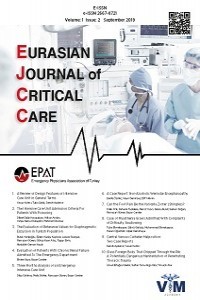Is Thrombolytic Therapy Safe after CPR for Patients with Pulmonary Embolism?
Is Thrombolytic Therapy Safe after CPR for Patients with Pulmonary Embolism?
___
- Referans1. Kourkouta, Lambrini & Konstantinos, Koukourikos & Christos, Iliadis & Petros, Ouzounakis & Areti, Tsaloglidou. (2018). Pulmonary Embolism: A Literature Review. 10.11648/j.ajns.s.2018070301.19.
- Referans2. Duru, Serap, et al. "Pulmoner embolide klinik, laboratuvar ve bilgisayarlı tomografi pulmoner anjiyografi sonuçları: 205 hastanın retrospektif değerlendirmesi." Anadolu Kardiyol Derg 12 (2012): 142-9.
- Referans3. Bĕlohlávek, Jan, Vladimír Dytrych, and Aleš Linhart. "Pulmonary embolism, part I: Epidemiology, risk factors and risk stratification, pathophysiology, clinical presentation, diagnosis and nonthrombotic pulmonary embolism." Experimental & Clinical Cardiology 18.2 (2013): 129.
- Referans4. Moore, Alastair JE, et al. "Imaging of acute pulmonary embolism: an update." Cardiovascular diagnosis and therapy 8.3 (2018): 225.
- Referans5. Authors/Task Force Members, et al. "2014 ESC Guidelines on the diagnosis and management of acute pulmonary embolism: The Task Force for the Diagnosis and Management of Acute Pulmonary Embolism of the European Society of Cardiology (ESC) Endorsed by the European Respiratory Society (ERS)." European heart journal 35.43 (2014): 3033-73.
- Referans6. Yin, Qin, Xiao Li, and Chunsheng Li. "Thrombolysis after initially unsuccessful cardiopulmonary resuscitation in presumed pulmonary embolism." The American journal of emergency medicine 33.1 (2015): 132-e1.
- Referans7. Wu, Jiang-Ping, et al. "Good neurological recovery after rescue thrombolysis of presumed pulmonary embolism despite prior 100 minutes CPR." Journal of thoracic disease 6.12 (2014): E289.
- Referans8. Yamamoto, Takeshi. "Management of patients with high-risk pulmonary embolism: a narrative review." Journal of intensive care 6.1 (2018): 16.
- Referans9. Aliyev, Dostali, Cihan Şahin, and Onur Özlü. "Masif Pulmoner Emboliye Bağlı Kardiyak Arrest ve Başarılı Sistemik Tromboliz."
- Referans10. Jiang-Ping Wu, Dan-Yan Gu, Sheng Wang, Zhen-Jun Zhang, Jian-Cang Zhou and Rui-Feng Zhang "A meta-analysis of cardiopulmonary resuscitation with and without the administration of thrombolytic agents." Resuscitation 70.1 (2006): 31-36.
- Referans11. Beydilli İ, Yılmaz F, Sönmez BM, Kozacı N, Yılmaz A, Toksul İH, et al "Thrombolytic therapy delay is independent predictor of mortality in acute pulmonary embolism at emergency service." The Kaohsiung journal of medical sciences 32.11 (2016): 572-78.
- Başlangıç: 2019
- Yayıncı: Acil Tıp Uzmanları Derneği
A young man with fever and throat pain
Is Thrombolytic Therapy Safe after CPR for Patients with Pulmonary Embolism?
Ramazan ÜNAL, Ramazan GÜVEN, Bensu BULUT, Kemal BİÇER, Ertuğrul AK, Basar CANDER
Angioedema developing in half of the tongue with captopril.
A RARE CAUSE OF INTESTINAL OBSTRUCTION OBTURATOR HERNI
Uğur ÖZSOY, Murat YILDIRIM, Sinan Cem GÜL, Ahmet ERDUR
A case of Intraabdominal Bleeding Presented With Massive Hemothorax
Ahmet ERDUR, Şervan KURT, Melih UÇAN, Hasan ÇAM, Ertuğrul AK, Eren SERT, Basar CANDER
Hepatic Portal Venous Gas in Emergency Department: A Case Report
Abdullah ALGIN, Serdar ÖZDEMİR, Hatice Şeyma AKÇA, Mehmet ERDOĞAN
Ahmet ERDUR, Hasan ÇAM, Melih UÇAN, Şervan KURT, Ömer Faruk TÜRKOĞLU, Basar CANDER
Renal colic in the pelvic kidney
Şeref Emre ATİŞ, Merve EKŞİOĞLU, Bora ÇEKMEN, Esra KARAMAN, Öner BOZAN
